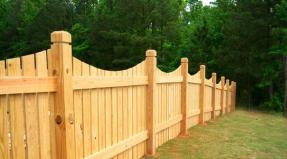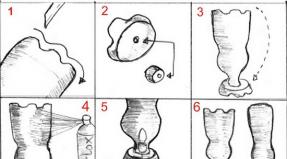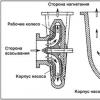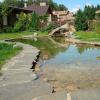How to strengthen the banks of the pond in the country from slipping and erosion with your own hands
A do-it-yourself artificial pond is the pride and decoration of a summer cottage. However, over time, the soil from the banks may begin to slide, which leads to cloudy water, accumulation of silt at the bottom, and also opens unaesthetic walls of the reservoir covered with a film. To prevent this from happening, it is necessary to strengthen the banks of the pond and only then decorate them. This can be done in various ways, the choice of which depends on financial capabilities, the size of the reservoir, as well as the features of its operation.
The banks of the pond can be strengthened in various ways.Assess the situation
Before deciding how to strengthen the shores of a future or existing reservoir, many factors should be taken into account. Among them:
- soil type - clay, sand;
- how gentle or steep the banks are;
- service life of the pond;
- the location of the plots from which the soil began to crumble;
- the location of the reservoir, its functional features;
- climate, probability of precipitation, depth of soil freezing.
Reliable and proven methods
If you are in doubt about how best to strengthen the walls of the reservoir, choose the most affordable and proven methods. Most often, the walls of the reservoir are strengthened with the help of mesh structures. As a rule, geogrids are used. Gabions are also effective, which also perfectly keep the walls of the pond from shedding. Let's discuss each of these methods in more detail.
 Geogrid reinforcement - a modern, inexpensive, reliable solution
Geogrid reinforcement - a modern, inexpensive, reliable solution To qualitatively fix the geogrid, you should properly prepare for installation. In addition to the base material, you will need a geotextile sheet for drainage, fixing elements - metal or plastic anchors, as well as stones or other material for filling the cells.
Before performing work, it is necessary to remove the top layer of soil and level the surface. Geotextiles are laid on the entire prepared area, and a grate is placed on top. Separate elements of the grid are fastened together to create a continuous layer of coating. Then the grating is filled with gravel, broken bricks or cement mortar.
If the cells are filled with earth, and then plants are planted in it, the roots of the plantations will provide additional fixation of the soil.
gabions
Gabions will provide effective strengthening of the walls of the reservoir. They are installed along the banks of the pond, connecting with each other and fixing the corners. The work will be cheaper if you make gabions with your own hands. To do this, you need to purchase a roll of galvanized mesh coated with PVC, 2m wide. From this material, you can make boxes with a maximum size of 500x500x1500mm. To prevent the box from falling apart, the corners of the structure are fastened with wire scraps from the same mesh.
 Gabions are a practical, durable, relatively inexpensive pond solution
Gabions are a practical, durable, relatively inexpensive pond solution With the help of such boxes, you can not only strengthen the walls, but also decorate the pond. The mesh structure, filled with rubble, is in perfect harmony with the natural design of the reservoir - water lilies, green spaces. Gabions allow you not to worry about the preparation of drainage, since they themselves have drainage properties. In a year or two, they become even more reliable support for the coast, due to filling the space between the crushed stone with sand and soil, as well as the growth of plantings.
Eco fix
Strengthening the soil along the edges of the reservoir can be done using environmentally friendly methods. For example, to plant plants that reinforce the earth with their roots. Choosing plants with an appropriate root system is not easy. In addition, it takes time to wait until they grow and braid the roots of the shore. There is a risk that the plantings will not take root. If you still decide to cope with the task in this way, pay attention to the following plant options:
- cattail;
- Red currant;
- sea buckthorn;
- marsh iris;
- sedge.
 Coconut mats can be lined with rocks or plants can be planted on them to hold the soil.
Coconut mats can be lined with rocks or plants can be planted on them to hold the soil. Another eco-friendly way to strengthen the shores is coconut mats. With their help, the walls of the reservoir will look smoother and more aesthetically pleasing. This method is suitable even for the steepest slopes, while the slopes must first be leveled. The mats are overlapped, capturing at least 20 cm of the neighboring one, and they are attached to the pond waterproofing film with mounting glue. Then you can do this: lay out the edges of the pond with stones, or, having poured a layer of soil, plant plants.
Piles - a professional way to strengthen the banks
Strengthening the slopes of a reservoir with piles is a reliable and effective method that has been known since ancient times. However, the installation of piles is a rather laborious process. Supports need to be driven deep into the ground, for which special equipment is used.
There are two types of piles that are used for reservoirs - wooden and plastic:
- If the material from which the piles are made is wood, it should be remembered that it is subject to decay. Partially, this disadvantage is corrected with the help of water-repellent impregnation. Over time, the processed piles begin to rot, so it is best to use larch as a base. This material is resistant to water, over time it only becomes stronger, it does not require additional processing.
- Today, PVC piles are used as an alternative to wood. This material is resistant to moisture, therefore, the props serve for decades. However, like wooden ones, they need to be mounted using special equipment. In this regard, pile reinforcement of the walls of the reservoir is not used for small ponds, only for large reservoirs.
In order for the pond in the country house to remain beautiful and aesthetic for a long time, it is better to take care of strengthening the walls of the pit even at the stage of its construction. Even better, if this task is solved by a landscape designer. He will take into account the wishes of the client, as well as the properties of the soil, the depth of the reservoir and the steepness of the slopes.



















